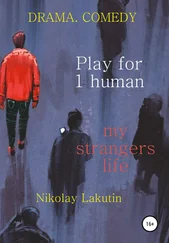Douglas Hofstadter - I Am a Strange Loop
Здесь есть возможность читать онлайн «Douglas Hofstadter - I Am a Strange Loop» весь текст электронной книги совершенно бесплатно (целиком полную версию без сокращений). В некоторых случаях можно слушать аудио, скачать через торрент в формате fb2 и присутствует краткое содержание. Жанр: Прочая документальная литература, на английском языке. Описание произведения, (предисловие) а так же отзывы посетителей доступны на портале библиотеки ЛибКат.
- Название:I Am a Strange Loop
- Автор:
- Жанр:
- Год:неизвестен
- ISBN:нет данных
- Рейтинг книги:4 / 5. Голосов: 1
-
Избранное:Добавить в избранное
- Отзывы:
-
Ваша оценка:
- 80
- 1
- 2
- 3
- 4
- 5
I Am a Strange Loop: краткое содержание, описание и аннотация
Предлагаем к чтению аннотацию, описание, краткое содержание или предисловие (зависит от того, что написал сам автор книги «I Am a Strange Loop»). Если вы не нашли необходимую информацию о книге — напишите в комментариях, мы постараемся отыскать её.
I Am a Strange Loop — читать онлайн бесплатно полную книгу (весь текст) целиком
Ниже представлен текст книги, разбитый по страницам. Система сохранения места последней прочитанной страницы, позволяет с удобством читать онлайн бесплатно книгу «I Am a Strange Loop», без необходимости каждый раз заново искать на чём Вы остановились. Поставьте закладку, и сможете в любой момент перейти на страницу, на которой закончили чтение.
Интервал:
Закладка:
My explorations did not teach me that any shape whatsoever can arise as a result of video feedback, but they did show me that I had entered a far richer universe of possibilities than I had expected. Today, this visual richness reminds me of the amazing visual universe discovered around 1980 by mathematician Benoit Mandelbrot when he studied the properties of the simple iteration defined by z → z 2+ c, where c is a fixed complex number and z is a variable complex number whose initial value is 0. This is a mathematical feedback loop where one value of z goes in and a new value comes out, ready to be fed back in again, just as in audio or video feedback. The key question is this: If you, playing the role of microphone and loudspeaker (or camera and TV), do this over and over again, will the z values you get grow unboundedly, sailing off into the wild blue (or wild yellow or wild red) yonder, or will they instead home in on a finite value?
The details need not concern us here; the basic point is that the answer to the question depends in a very subtle way on the value of the parameter c , and if you make a map by color-coding different values of c according to the rate of z’ s divergence, you get amazing pictures. (This is why I joked about the “wild yellow” and “wild red” yonders.) Both in video feedback and in this mathematical system, a very simple looping process gives rise to a family of truly unanticipated and incredibly intricate swirling patterns.
The Phenomenon of “Locking-in”
The mysterious and strangely robust phenomena that emerge out of looping processes such as video feedback will serve from here on out as one of the main metaphors in this book, as I broach the central questions of consciousness and self.
From my video voyages I have gained a sense of the immense richness of the phenomenon of video feedback. More specifically, I have learned that very often, wonderfully complex structures and patterns come to exist on the screen whose origins are, to human viewers, utterly opaque. I have been struck by the fact that it is the circularity — the loopiness — of the system that brings these patterns into existence and makes them persist. Once a pattern is on the screen, then all that is needed to justify its staying up there is George Mallory’s classic quip about why he felt compelled to scale Mount Everest: “Because it’s there!” When loops are involved, circular justifications are the name of the game.
To put it another way, feedback gives rise to a new kind of abstract phenomenon that can be called “locking-in”. From just the barest hint (the very first image sent to the TV screen in the first tiny fraction of a second) comes, almost instantly (after perhaps twenty or thirty iterations), the full realization of all the implications of this hint — and this new higher-level structure, this emergent pattern on the screen, this epiphenomenon, is then “locked in”, thanks to the loop. It will not go away because it is forever refreshing itself, feeding on itself, giving rebirth to itself. Otherwise put, the emergent output pattern is a self-stabilizing structure whose origins, despite the simplicity of the feedback loop itself, are nearly impenetrable because the loop is cycled through so many times.
Emergent New Realities of Video Feedback
Coming up with vivid and helpful nicknames for unexpected visual patterns had certainly not figured in my initial plans for my video voyage at Stanford, but this little game soon became necessary. At the outset, I had thought I was undertaking a project that would involve straightforward terms like “screen inside screen”, “silver strip”, “angle of tilt”, “zooming in”, and so forth — but soon I found myself forced, willy-nilly, to use completely unexpected descriptive terms for what I was observing. As you have seen, I started talking about “corridors” and “walls”, “doorways” and “galaxies”, “spirals” and “black holes”, “hubs” and “spokes”, “petals” and “pulsations”, and so forth. In the second video voyage with Bill, many of these same terms were once again needed, and some new ones were called for, such as “starfish”, “cheese”, “fire”, “foam”, and others.
Such words are hardly the kind of language I had thought I would be dealing with when I first broached the idea of video feedback. Although the system to which I was applying these terms was mechanical and deterministic, the patterns that emerged as a consequence of the loop were unpredictable, and therefore it turned out that words were needed that no one could have predicted in advance.
Simple but evocative metaphors like “corridor”, “galaxy”, and others turned out to be indispensable in describing the abstract shapes and events I witnessed on the screen. The initial terms I had tacitly assumed I would use wound up getting mostly ignored, because they yielded little insight. Of course, in principle, everything could be explained in terms of them, in a rigorous and incomprehensibly verbose fashion (like explaining a gas’s temperature and pressure by writing out Avogadro’s number of equations) — but such a boringly reductionistic, nearly pixel-by-pixel explanation would entirely leave out the wonderful higher-level visual phenomena to which a human eye and mind intuitively resonate.
In short, there are surprising new structures that looping gives rise to that constitute a new level of reality that could in principle be deduced from the basic loop and its detailed properties, but that in practice have a different kind of “life of their own” and that demand — at least when it comes to extremely finite, simplicity-seeking, pattern-loving creatures like us — a new vocabulary and a new level of description that transcend the basic level out of which they emerge.


CHAPTER 6
Of Selves and Symbols

Perceptual Looping as the Germ of “I”-ness
IFIND it curious that, other than proper nouns and adjectives, the only word in the English tongue that is always capitalized is the first-person pronoun (nominative case) with which this sentence most f lamboyantly sets sail. The convention is striking and strange, hinting that the word must designate something very important. Indeed, to some people — perhaps to most, perhaps even to us all — the ineffable sense of being an “I” or a “first person”, the intuitive sense of “being there” or simply “existing”, the powerful sense of “having experience” and of “having raw sensations” (what some philosophers refer to as “qualia”), seem to be the realest things in their lives, and an insistent inner voice bridles furiously at any proposal that all this might be an illusion, or merely the outcome of some kind of physical processes taking place among “third-person” ( i.e., inanimate) objects. My goal here is to combat this strident inner voice.
I begin with the simple fact that living beings, having been shaped by evolution, have survival as their most fundamental, automatic, and built-in goal. To enhance the chances of its survival, any living being must be able to react flexibly to events that take place in its environment. This means it must develop the ability to sense and to categorize, however rudimentarily, the goings-on in its immediate environment (most earthbound beings can pretty safely ignore comets crashing on Jupiter). Once the ability to sense external goings-on has developed, however, there ensues a curious side effect that will have vital and radical consequences. This is the fact that the living being’s ability to sense certain aspects of its environment flips around and endows the being with the ability to sense certain aspects of itself.
Читать дальшеИнтервал:
Закладка:
Похожие книги на «I Am a Strange Loop»
Представляем Вашему вниманию похожие книги на «I Am a Strange Loop» списком для выбора. Мы отобрали схожую по названию и смыслу литературу в надежде предоставить читателям больше вариантов отыскать новые, интересные, ещё непрочитанные произведения.
Обсуждение, отзывы о книге «I Am a Strange Loop» и просто собственные мнения читателей. Оставьте ваши комментарии, напишите, что Вы думаете о произведении, его смысле или главных героях. Укажите что конкретно понравилось, а что нет, и почему Вы так считаете.












